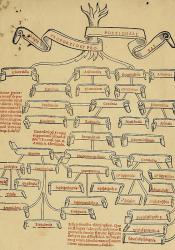Venice, Italy
Venice (along with Florence) was a publishing giant throughout the Renaissance. Thus, it is the site to which Pacioli traveled to publish both of his works: Summa de arithmetica, geometria, proportioni et proportionalita (in 1494) and De Divina Proportione (1509). De Divina Proportione included sixty illustrations by da Vinci, and these sixty sketches would constitute the only work of da Vinci that would be published during his lifetime. An interesting fact about both texts is that they were published in Italian (the vernacular) rather than Latin.
Sources
Isaacson, Walter. Leonardo Da Vinci. Simon & Schuster Paperbacks, 2018.
“Luca Pacioli.” Luca Pacioli (1445-1517), School of Mathematics and Statistics, University of St. Andrews, Scotland, www-history.mcs.st-and.ac.uk/Biographies/Pacioli.html.
Parent Map
Coordinates
Longitude: 12.315515100000


